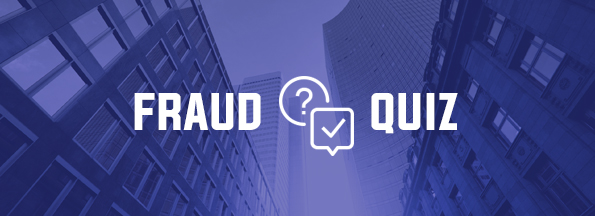Test Your Fraud Knowledge

International Fraud Awareness Week begins next week. The point of Fraud Week, sponsored by the Association of Certified Fraud Examiners (ACFE), is to raise the visibility of occupational fraud and abuse, and to remind organizations to review and improve their fraud prevention and detection capabilities.
In case you’re thinking fraud is not an issue in your organization, you should know that extrapolating from actual fraud cases examined in 2016 and reported to ACFE, organizations worldwide lose 5% of topline revenue to fraud. Virtually every type of organization from business, government to non-profit sectors is vulnerable to fraud.
How much do you know about occupational fraud and abuse with respect to your organization? Prepare for Fraud Week by trying your hand at these questions based on ACFE’s 2016 Report to the Nations on Occupational Fraud and Abuse (answers are below):
1. Occupational frauds are most often detected in which way:
a) By accident
b) Through a management review
c) By a tip
d) By an internal audit
2. The median duration of occupational fraud is:
a) 3 months
b) 6 months
c) 18 months
d) 24 months
3. About what percentage of occupational frauds are committed by 2 or more in collusion?
a) 19%
b) 37%
c) 48%
d) 62%
4. What is the median loss to fraud?
a) $110,000
b) $150,000
c) $225,000
d) $1,000,000
5. The proportion of the 2016 fraud cases in the U.S. committed by owners or executives is:
a) 5%
b) 10%
c) 15%
d) 20%
6. The median loss to fraud for companies with less than 100 employees as compared to companies with 10,000+ employees are:
a) Much smaller
b) Proportionately smaller
c) About the same
d) Larger
7. The largest proportion of fraud is perpetrated by employees who have been with the organization:
a) Less than 1 year
b) 1 to 5 years
c) 6 to 10 years
d) More than 10 years
Answers
- c) By a tip. In 2016, tips were the most common detection method by a wide margin, accounting for 39.1% of cases. Hotlines were especially effective in generating tips.
- c) 18 months. The longer the fraud continues undetected, the higher the cost. 20% of the cases in 2016 were undetected for 36 months or longer, and cases that endured for 60+ months caused a median loss of $850,000.
- c) About 48%. In cases of fraud by collusion, the cost of the crime increased as more people were involved. A single fraudster caused a median $85,000 in losses, while a collaboration of 5 or more cost $833,000.
- b) $150,000 was the median loss. However, the average loss per case was $2.7 million, indicating that losses due to occupational fraud can be very significant.
- d) About 20%. Median loss due to fraud by U.S. owners or executives was far higher at $500,000 than for managers ($150,000) or employees ($54,000). Part of the difference is due to the fact that owner or executive fraud went undetected longer.
- c) About the same. In 2016, the median loss of a fraud case in an organization of less than 100 employees was $150,000, the same as for an organization with 10,000 or more employees. The relative impact of the loss was obviously much greater for the smaller organizations.
- b) 1 to 5 years. Employees are more likely to commit a fraud if they are familiar with the controls and systems in place, or when something in their circumstances changes over time. However, the median loss for a fraud increases regularly as the employee’s tenure lengthens.
You can learn a lot about occupational fraud and abuse by reading the 2016 Report to the Nations. Better yet, you can begin to see how you can improve your fraud prevention program to avoid being one of the cases in the Report.